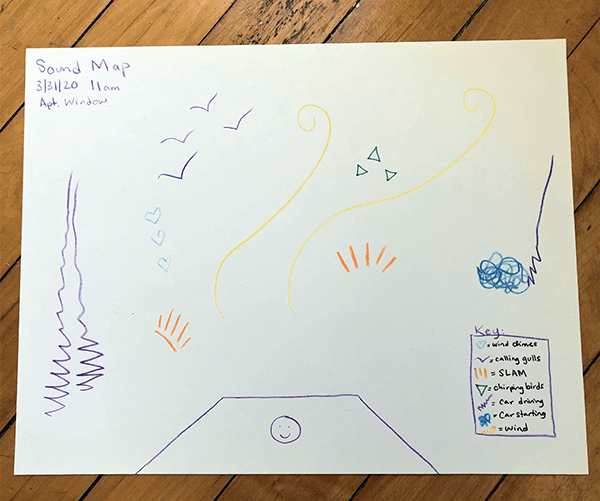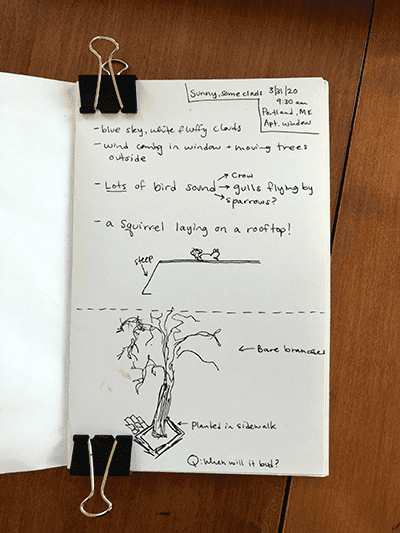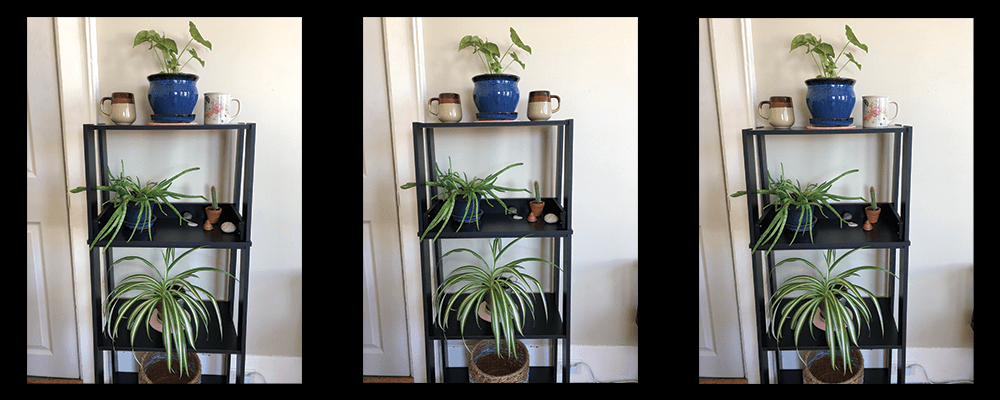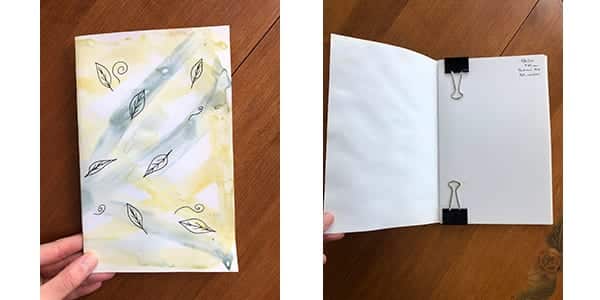
Elementary Module 1: Observation
45 mins – 1+ hr
How can we practice observation? What do we notice when we pay close attention? What changes stand out? What patterns emerge?
Introduction Video : ~1 min
One opportunity our current “stay at home” situation offers is to really focus our attention on our surroundings. We have a unique chance right now to really learn our homes, yards, and neighborhoods in a new way…a way that can help us learn and get to know different habitats and natural areas in the future when we can explore more freely.
We’re going to practice the fun and important skill of observation. Observation is the close, careful study of something in order to gain information or better understand it. While that definition on it’s own isn’t very exciting, our observation skills are the special powers that help us notice and see amazing things in nature. By honing these skills we can: notice new birds in our neighborhood, spot a squirrel carrying leaves for its nest, learn when our favorite tree seen from our window forms buds…try out the activities below to start your own observation practice.
Making A Simple Nature Journal: 15-30 mins
Start by making a booklet of folded paper to use as your own nature journal to record observations in! We’ll use it today, but also throughout the spring. The kinds of observation activities we’ll do in our nature journal can continue as our at-home learning does, so feel free to include plenty of pages inside your journal (you can always add more, too)! You can use a journal or notebook you already have around the house, but it’s especially fun to take on the simple project of making your own.
Now it’s time to begin your first journal entry. Settle into your observation spot (or a new one) with your journal and something to write/draw with. Your spot might be at a window looking outside on a garden bed, at a table on your back deck, near a stump in your yard, or in a nearby natural area your family visits often (giving lots of space to other people, of course).

- In one of the top corners, write down the basics:Date and time:
Location – general and specific (in Portland, near my living room observation window or sat beneath the big tree in my backyard)
Weather – even if you don’t have a way to check the forecast, notice what you see and feel (windy, cool, blue skies, etc.) If you can, note the actual temp. - Choose something in nature that catches your attention today! Look up, down, zoomed out and zoomed in. Spend at least 5 minutes looking and listening and feeling. Jot down what you’re noticing in your journal, but try to save room on your page. Pay attention to colors, shapes, sounds, movement, etc.
- Spend at least 5 more minutes recording these observations in the space you left. Look closely at one thing or area, and try to capture what you see, hear, or notice using both drawings and words. The goal isn’t to make a perfect drawing of what you imagine a flower to look like, but to somehow represent what you actually see or notice.
- If you think you’re done – look again! What did you miss? What isn’t captured in your journal that stands out to you now? Add a note or picture to include this and other features that were less obvious at first.
- Older students might want to write down questions that come up during this time, to be researched later.
Sound Maps, 10-15 mins

Listening closely is a great way to learn about a place, and this activity will guide you in doing just that. Sound maps help us record and note that we can hear from a given spot, at a given time. Sit down outdoors or near an open window with 2 things: something to write with and a piece of paper. You can use one color or many, pencil or pen. Some people prefer more room to draw for sound maps than the half sheets in your journal – that’s totally up to you! You can always staple or clip these extra pages in. As with journaling, include the date, time, and location.
On the paper in front of you, make a simple symbol (like an X or a smiley face) to represent yourself and begin listening for any sounds.
Outside Option:
If you’re outdoors you may hear things in all directions so place the ‘you’ symbol in the center of the page. As you listen, be sure to turn your head (and attention!) as you’ll stay in this one spot during the activity.
Inside Option:
Indoors at a window, you may not be able to hear things behind you so your ‘you’ symbol can be towards the bottom of the page. Through the window, try to notice which side or direction the sounds come from.
No matter if you’re inside or out, when you hear a sound and notice its direction, mark on the map to show what you heard and where you heard it. You can draw a small picture, use words, or even a symbol. Maps usually include a key to help you understand the symbols – go ahead and include one of these on your sound map or label the sounds themselves! Whatever you use to represent each sound can be creative or realistic. I used hearts to show the sound of a windchime and a harsh scribble blob to show a car engine starting. Small birds chirping are shown by small triangles and the loudly-calling gulls are represented by big stick-figure-style birds.
Do this for as long as your attention holds or until your page is full! Admire your work and consider revisiting this activity and spot at a different time – morning vs evening, early spring vs late spring. You might notice big changes or observe what sounds are more constant.
Observation Game: Change One Thing, 5-15 mins
Games can help us practice our observation skills, too! “I Spy” is a classic that most of us know. At Maine Audubon’s camps (and many others, I’m sure) we also play a game called “Change One Thing” that’s perfect for working on our visual observation. This game can be played in so many ways! All it takes is 2 people, but you can play with many more if you have a large household. Here I’ll describe 2 versions to try – let us know if you have other variations!

Version 1: An area such as a small room, a dollhouse, or a shelf
- Start by establishing a baseline – have everyone study the area closely for 1 minute
- Choose someone to be “it” – they will change ONE thing in the chosen area while the other players close their eyes or turn away
- The other players then take turns guessing what has changed!
- Set a limit for number of guesses before the person who was “it” must reveal what was changed, such as 3 or 4 guesses
- Choose someone else to be “it”, and repeat!
Version 2: A person
- Choose someone to be “it”
- Establish a baseline by having the other players study whoever is “it” closely for 1 minute, noticing accessories, hairstyles, shoes, buttons, etc.
- Whoever is “it” then steps away to a nearby room or area. They change ONE thing about themselves
- When ready, they return to the group who take turns guessing what has changed!
- Set a limit for number of guesses before the person who was “it” must reveal what was changed, such as 3 or 4 guesses
- Choose someone else to be “it”, and repeat!
Next Generation Science Standards
“Crosscutting Concepts” for all Elementary Grades in this module:
- Patterns
- Systems and System Models
- Structure and Function
- Stability and Change
K Performance Expectations:
- Use observations to describe patterns of what plants and animals (including humans) need to survive. K-LS1-1
- Use and share observations of local weather conditions to describe patterns over time. K-ESS2-1
1st Grade Performance Expectations:
- Make observations to construct an evidence-based account that young plants and animals are like, but not exactly like, their parents. 1-LS3-1
- Use observations of the sun, moon, and stars to describe patterns that can be predicted. 1-ESS1-1
- Make observations at different times of year to relate the amount of daylight to the time of year. 1-ESS1-2
2nd Grade Performance Expectations:
- Make observations of plants and animals to compare the diversity of life in different habitats. 2-LS4-1
3rd Grade Performance Expectations:
- Construct an argument that some animals form groups that help members survive. 3-LS2-1
- Construct an argument with evidence that in a particular habitat some organisms can survive well, some survive less well, and some cannot survive at all. 3-LS4-3
- Make observations and/or measurements of an object’s motion to provide evidence that a pattern can be used to predict future motion. 3-PS2-2
4th Grade Performance Expectations:
- Construct an argument that plants and animals have internal and external structures that function to support survival, growth, behavior, and reproduction. 4-LS1-1
NGSS Lead States. (2013). Next Generation Science Standards: For States, By States. Retrieved from http://www.nextgenscience.org/

